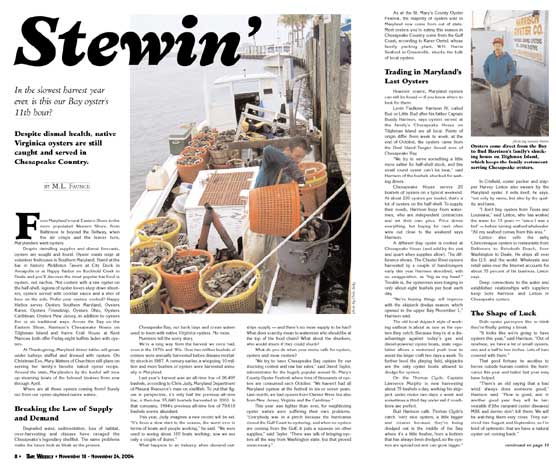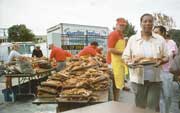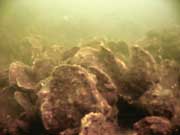|
 Dock of the Bay Dock of the Bay
Bay Weekly’s Own Take Home Prizes
Oysters and shad make winners of writer and columnist
by Carrie Steele
There wasn’t a red carpet. No thousand-dollar Oscar-night glamour outfits. There weren’t even any golden trophies. But writers from Maryland and beyond were crossing their fingers last week for a chance to win the MDDC Press Association’s 2005 editorial awards.
Each year, a different region’s press association reviews the finest stories from member papers in Maryland, Delaware and the District of Columbia. This year, journalist cousins to the south, members of the Alabama Press Association, doled out the awards.
Two longtime Bay Weekly writers — Bill Burton and M.L. Faunce — won awards for their 2004 writing. Bay Weekly, printing 17,500 papers a week, competes in Division E, non-dailies that circulate between 10,001-20,000 papers.
M.L. Faunce won first place in the business/economics category for “Stewin’: Despite Dismal Health, Native Virginica Oysters Are Still Caught and Served in Chesapeake Country” (Vol. 12, Issue 47). Additionally, her story earned Best in Show.
At Thanksgiving, Maryland dinner tables will groan under turkeys stuffed and dressed with oysters ... Where are all those oysters coming from? Surely not from our oyster-depleted native waters, wrote Faunce of Marylanders in search of native oysters.
“I got the chance to see watermen and hand-tongers stand on the side of their boats and do a dance they’ve done for centuries,” said Faunce of Stewin’. “And then I got to try it myself.”
Her glimpse into the oyster industry won praise from the editors and writers who judge the competition. “A very detailed, in-depth piece of writing. Clear and interesting,” the judges wrote.
The Best in Show award picks from the pool of all first-place winners in a given category. In claiming the prize, Bay Weekly’s first Best of Show ever, Faunce beat out papers large and small that won first in the category, including The Baltimore Sun and The Capital.
Faunce. who has been writing for Bay Weekly for more than a decade, won another first prize for oyster writing last year. “Wrangling Oysters Out of Trouble,” won the vote of North Carolina’s judges last year as a science story.
“Winning made me think about oysters again,” said Faunce. “Maryland Department of Natural Resource’s Chris Judy, whose cover photo was used, told me that as much as he enjoyed eating oysters and working with oysters, he enjoyed reading about them in Bay Weekly,” Faunce said. She seconded Judy’s opinion, adding that she also enjoys writing about oysters for Bay Weekly.
Bill Burton won a second-place prize for sports columns in Bay Weekly’s division. That’s the most recent of hundreds of awards Burton has taken in a journalism career spanning seven decades.
His column, “Hail to Shad, the Fish that Fed American Independence,” (Vol. 12, Issue 10), told the story of shad fishing in the Bay and looked at the possible lifting of shad’s catch-and-keep moratorium.
I’m wondering what those shad (and herring) from the Atlantic think as they move upriver and find they can go unimpeded much farther — no escalators, ladders or elevators needed — than in many decades or even centuries, wrote Burton.
Burton, outdoor columnist with the Evening Sun for 37 years, has written his column for Bay Weekly since the paper was founded in 1993. He began his column just months after the paper’s inaugural issue.
“I’m a shad fisherman, and I wanted to tell the story of shad because people are no longer familiar with them. You can’t keep shad anymore in Maryland,” Burton said. “I wanted to tell people what shad fishing was like in the good old days.”
Faunce and Burton join a dynamic team of writers, editors, managers, sales representatives and designers that bring you a fresh Bay Weekly every week of the year.
“An editor works with a writer to tell the best story, in the smoothest most readable way,” said Bay Weekly editor-in-chief Sandra Martin. “You know you’ve succeeded when readers tell you they liked a story. When other writers and editors say it’s the best story of its kind in a three-state region, you want to bottle that success and sprinkle it on every writer’s story.”

 Governor’s Green Report Card Wilts Governor’s Green Report Card Wilts
There’s room for improvement, says environmental group
by Carrie Steele
The word midterm may be striking anxiety into the hearts of students in their spring semesters. It’s not just students this time who are up for a grade: Report-card time on State Circle put Gov. Robert Ehrlich under the magnifying glass last week.
The Maryland League of Conservation Voters released its midterm scorecard for Gov. Robert Ehrlich’s four-year term. Computing the grade for January 2004 through December 2004, the League reviewed eight categories — air quality, water quality, energy, fisheries and wildlife, smart growth, transportation, land preservation and open space plus administration and appointments.
His composite grade: D+.
In breakdown, categories on the governor’s report card ranged from a B in water quality to F’s in both transportation and Open Space.
In calculating grades, the environmental watchdog for Maryland state government asked more than 20 environmental and public interest leaders from across Maryland to grade the governor’s agency actions, positions on legislation, funding, statements and appointments.
“They looked at what type of actions the governor’s taken, if it was something the governor had control over or not,” said Susan Brown, executive director of the Maryland League of Conservation Voters. “His grade also reflects issues that had a high level of importance to the environmental community.”
Governor Ehrlich’s 2004 Bay Restoration Fund and brownfields reforms both earned high marks. But other measures and neglected issues dragged down his overall score. The governor was penalized for diverting funds from Project Open Space, a project funded exclusively to purchase land for conservation by money generated from the earmarked real-estate transfer tax.
His score was also lowered for advocating the Inter-County Connector and for dismantling the Office of Smart Growth.
“The ICC is ahead of schedule,” said Governor Ehrlich in his 2004 State of the State address. The report card’s summary, however, notes that the costly ICC would drain transportation dollars that could support less destructive projects.
Under scrutiny from the beginning was the governor’s nomination of Lynn Buhl, an auto industry executive, for Department of Environment. The pattern was reinforced by the nomination of former Del. Ken Schisler, who scored a 23 percent on his own environmental report card, to chair the Public Service Commission.
This year’s appointment of Ron Guns as Department of Natural Resources’ Chesapeake Bay Program assistant secretary raised new alarms. The former Cecil County delegate chaired the House Environmental Committee yet earned a composite score of 25 percent for the years 1995 to 1998 and 50 percent in the 1999-2000 session from the Maryland League of Conservation Voters.
The League also marked the governor Needs Improvement in the category Open and Assessable Government.
The governor’s press office did not respond to repeated requests for comment.
“The governor’s just not doing enough,” Brown said. “We need a lot of different solutions — not just one. The Bay Restoration Fund was good, but there are a lot of things that still need to be done with a more comprehensive approach.”
At midterm, Governor Ehrlich has two years to pull up his grades.
“It’s just a little out of sync with what Marylanders value,” Brown said. “Marylanders rank the environment very high and hope their officials do the same.”
See the full report card at www.mdlcv.org
 |
photo by M.L. Faunce
More than 2,500 people pounded mallets against the shells of hundreds of bushels of crabs at the annual Annapolis Rotary Crab Feast. April 1, the Rotary Club chooses which civic-minded groups will share in the $31,500 raised. |
Turning Blue Crabs into Greenbacks
Community groups cash in on bounty raised from autumn’s crab Feast
by Carrie Steele
Next summer’s blue crabs may be getting cabin fever right about now.
“Right now, they’re just hunkered down in the mud, overwintering,” says Lynn Fegley, blue crab program manager for the Maryland Department of Natural Resources. At the end of this month, as water temperatures rise, they’ll emerge from the mud and swim north in time for crabbing season, which begins April 1 and lasts through summer and fall.
Last autumn, you may have savored blue crabs at the Annapolis Rotary Crab Feast.
Each year, more than 2,500 crab-lovers descend upon Navy-Marine Corps Memorial Stadium to devour hundreds of bushels of crabs, a field of corn on the cob, as well as crab soup and beef barbeque. Eating at picnic-style tables, you get your fill of crab to last you through the winter months.
April 1 also brings that feast full circle, marking the day the crab feast committee divvies up its $31,500 to area organizations for public-spirited projects. This year, Annapolis Rotarians have $1,500 more than last year’s $30,000 to fund projects.
“The crab feast is a community service project, because it is something we do for the community, and then we give the money back to the community,” said Mimi Jones, former president of the Annapolis Rotary.
Annapolis Rotary is accepting grant applications through the end of March. Then, they’ll roll crabs over into dollar signs for local organizations and charities.
Last year, 26 organizations of the 30 that applied received grants for their projects. Grant winners included organizations small and large, including environmental, education, healthcare, social reform, and arts and music groups. A few of last year’s grantees were the Boys and Girls Club, Maryland Hall for the Creative Arts, Annapolis Maritime Museum, Hospice of Chesapeake and Friends of Quiet Waters Park.
“We like to fund things that people get a direct benefit from, like music for the Chorale,” Jones said. “We like to fund things that are objects, like camps for children or equipment for the hospital.”
To meet the qualifications, a group’s project must reach out to the Annapolis community, be a specific project (they won’t fund normal operating expenses) and better the quality of life for Annapolitans. The committee also gives partial funding to organizations whose projects have great expenses.
“We get a lot of applications and certainly can’t satisfy them all,” Jones said.
Come summer, the circle starts anew as the 60th Crab Feast returns to its traditional date — the first Friday in August — which is August 5, 2005.
The deadline for applications is March 31, 2005. Visit www.annapolisrotary.com to download an application; mail to Annapolis Rotary Club, P.O. Box 603, Annapolis, MD 21401.
 |
Where We Live
by Steve Carr |
If It’s Saint Patrick’s Day, Those Birds Must Be Irish
Lift a pint to the sky to the osprey, who delivers spring to us each year.
March 17 is a big day around the Bay. And, no, not just because that’s the day when we all get to pretend we’re Irish by wearing the green and downing copious amounts of green beer. March 17 is important because that’s the day osprey return to the Chesapeake. Don’t ask me how they do it. It’s about the closest thing to magic that I’ve ever seen.
Osprey are the ultimate snowbirds. Like the fair weather folks who summer around the Bay and winter down in warm and sunny Florida, osprey spend their spring and summer in the Chesapeake, then fly down to Central or South America in September.
Every St. Patrick’s Day, they come back. I go down to the Severn River to look for osprey this day every year. Sure enough, they are always there, no matter the weather. There can be snow on the ground or gale-force winds blowing in from the north. There they will be, just like clockwork.
I think we all take osprey for granted because there are so darn many of them around the Bay. I’ve read that the Bay is known as “the osprey garden of the world.”
Such abundance was not always the case. Back in the 1950s and ’60s, pesticides reduced the osprey numbers in the Bay to about 700 pairs.
That’s another neat thing about osprey. They mate for life, and they return as a team — usually to the same nest they occupied the previous year, especially if they successfully raised young there. If the nest is gone, they will stake their claim to the perch or pole it was sitting on. Once they have regained their strength after their arduous flight north, they start hauling lumber — big pieces of driftwood — and begin nesting anew.
The osprey spend the spring building their nests and courting one another. This is their quiet time. You don’t hear much of their familiar Beep! Beep! Beep! whistle until they have produced their offspring and taken to the air in search of fish.
There are currently 2,000 nesting pairs of osprey scattered across the Chesapeake, according to the U.S. Fish & Wildlife Service’s estimate. You’ll find their nests in some amazing places: on the Key Bridge in Baltimore and beside the Bethlehem Steel Plant at Sparrows Point, for instance.
Those big ugly cell phone towers dotting the landscape have also become home to many osprey nests. Right after you cross the Route 50 bridge over the Severn heading west, a cell phone tower hosts an annual pair of osprey. They perch there high above the passing traffic like winged gods overlooking their kingdom. Every time I drive by on that stretch of road, I honk my horn three times in greeting, trying to imitate their hunting call.
Osprey are called fish hawks because that’s what they live for: fish. They prefer menhaden, sunfish, perch and rockfish. They capture their prey in distinctive style. The pair tends to hunt together, one hanging back or flying slightly higher than its mate, soaring menacingly above the water until they spot a fish. Then they drop from the sky like a rock and hit the water feet first, grabbing the unsuspecting fish in their sharp talons before quickly regaining the air.
I remember seeing one of a pair of hunting osprey nail a large rockfish near the Naval Academy Bridge. The fish was so big the osprey had a hard time getting airborne. It ended up flying precariously, only a few inches above the water, battling a fierce headwind but unwilling to drop its dinner.
I have heard stories that osprey sometimes grab a fish that’s so big they can’t fly away with it, so they end up drowning. Once they lock onto a fish with their talons, they’re locked. There’s no turning back. They can’t release the fish while in the water. So, if they miscalculate the fish’s size, they can find themselves being dragged under to their death.
Summer is a busy season for the osprey because they have hungry young mouths to feed. They usually give birth to one or two fast-growing offspring. The hatchlings grow quickly because by September they will be facing a thousand-mile flight south with their parents. The seasonal migration waits for no bird.
So lift a pint to the sky and salute the noble osprey, who delivers spring to us each year and asks only for a few fish in return.
 |
| by Dr. Frank Gouin |
The Bay Gardener
Pruning Crape Myrtle
(Part II)
If you prune crape myrtle now, before the sap begins to flow, you can do most of the pruning using leather gloves to wipe away all small twiggy stems. Use your pruners to cut out all crossing branches and low-angled branches that interfere with mowing the lawn or gardening. Next cut back all stems that produced flowers last year and prune out all stems that are smaller than a pencil in diameter.
 Your efforts are to eliminate weak twiggy stems to prevent weak twiggy wood that will produce small clusters of small flowers. By pruning severely, you are limiting the number of vegetative buds on each stem. Fewer vegetative buds means that the remaining buds will grow into stronger stems because of limited competition, which in turn will produce large clusters of flowers. By pruning severely you are also improving the circulation of air through the plant canopy, thus reducing problems with powdery mildew on flowers and leaves. Your efforts are to eliminate weak twiggy stems to prevent weak twiggy wood that will produce small clusters of small flowers. By pruning severely, you are limiting the number of vegetative buds on each stem. Fewer vegetative buds means that the remaining buds will grow into stronger stems because of limited competition, which in turn will produce large clusters of flowers. By pruning severely you are also improving the circulation of air through the plant canopy, thus reducing problems with powdery mildew on flowers and leaves.
Using your leather glove, wipe away all small twiggy stems with a quick swipe of the hand. If you delay pruning until growth starts, you will have to remove these twiggy stems with pruning shears.
Normally a single pruning a year is all that is needed to keep our plants healthy. If your crape myrtle does not produce strong healthy stems and large flowers after having been pruned as described, it may need to be fertilized. Most crape myrtle recover quickly from a good heavy pruning.
Professor Emeritus Francis Gouin retired from the University of Maryland, where he was the state’s extension specialist in ornamental horticulture. Follow his column of practical gardening and plant advice every week, only in Bay Weekly. Ask Dr. Gouin your questions at [email protected].
Way Downstream
 In Baltimore, consultants must have told Mayor Martin O’Malley that playing in a band isn’t gubernatorial. The ’06 would-be Democratic nominee declared in an email this week to friends that he was quitting O’Malley’s March after his St. Patrick’s Day gig at the Avalon Theatre in Easton on March 19. “It’s hard to jump around with a guitar when you hit 41,” he told WBAL … In Baltimore, consultants must have told Mayor Martin O’Malley that playing in a band isn’t gubernatorial. The ’06 would-be Democratic nominee declared in an email this week to friends that he was quitting O’Malley’s March after his St. Patrick’s Day gig at the Avalon Theatre in Easton on March 19. “It’s hard to jump around with a guitar when you hit 41,” he told WBAL …
In Cambridge, native oysters may soon see a baby boom in their population, due to a newly finished oyster hat chery building at Horn Point Lab, part of the University of Maryland’s Center for Environmental Science. Now, Horn Point Lab breeds and raises 95 percent of oysters planted in restoration projects. The new nursery, four times the size of the old facility, will double the amount of baby bivalves scientists can raise for restoration … chery building at Horn Point Lab, part of the University of Maryland’s Center for Environmental Science. Now, Horn Point Lab breeds and raises 95 percent of oysters planted in restoration projects. The new nursery, four times the size of the old facility, will double the amount of baby bivalves scientists can raise for restoration …
Crabbing elsewhere: In California, the General Assembly wants to limit crab boats to 250 pots in an effort to replenish the dwindling stock of Dungeness crabs. The crustaceans got so scarce this season after 1,000-pot boats moved in that many crabbers pulled their gear in January, five months early …
In Colorado, the plan for a St. Patrick’s Day bash at a Bennigan’s was an old-fashioned goldfis h-swallowing contest. But People for the Ethical Treatment of Animals intervened, and the town of Arvada agreed that dropping the fish in alcohol amounted to cruelty. So the restaurant canceled the goldfish plan (which sounded to us about as appetizing as green beer) … h-swallowing contest. But People for the Ethical Treatment of Animals intervened, and the town of Arvada agreed that dropping the fish in alcohol amounted to cruelty. So the restaurant canceled the goldfish plan (which sounded to us about as appetizing as green beer) …
Our Creature Feature comes from Wisconsin, where a proposal that would allow hunters to shoot feral cats has stirred up a whole lot of hissing and clawing.
The Wisconsin Conservation Congress, which advises state regulators, surely didn’t anticipate the response when it floated the idea of reclassifying feral cats as “unprotected species” that could be shot by anyone with a license to hunt small game. The rationale? Cats kill songbirds. In a short time, the group fighting cat-killing has drawn thousands of hits at www.dontshootthecat.com.
|


 Dock of the Bay
Dock of the Bay
 Governor’s Green Report Card Wilts
Governor’s Green Report Card Wilts


 Your efforts are to eliminate weak twiggy stems to prevent weak twiggy wood that will produce small clusters of small flowers. By pruning severely, you are limiting the number of vegetative buds on each stem. Fewer vegetative buds means that the remaining buds will grow into stronger stems because of limited competition, which in turn will produce large clusters of flowers. By pruning severely you are also improving the circulation of air through the plant canopy, thus reducing problems with powdery mildew on flowers and leaves.
Your efforts are to eliminate weak twiggy stems to prevent weak twiggy wood that will produce small clusters of small flowers. By pruning severely, you are limiting the number of vegetative buds on each stem. Fewer vegetative buds means that the remaining buds will grow into stronger stems because of limited competition, which in turn will produce large clusters of flowers. By pruning severely you are also improving the circulation of air through the plant canopy, thus reducing problems with powdery mildew on flowers and leaves. In Baltimore, consultants must have told Mayor Martin O’Malley that playing in a band isn’t gubernatorial. The ’06 would-be Democratic nominee declared in an email this week to friends that he was quitting O’Malley’s March after his St. Patrick’s Day gig at the Avalon Theatre in Easton on March 19. “It’s hard to jump around with a guitar when you hit 41,” he told WBAL …
In Baltimore, consultants must have told Mayor Martin O’Malley that playing in a band isn’t gubernatorial. The ’06 would-be Democratic nominee declared in an email this week to friends that he was quitting O’Malley’s March after his St. Patrick’s Day gig at the Avalon Theatre in Easton on March 19. “It’s hard to jump around with a guitar when you hit 41,” he told WBAL … h-swallowing contest. But People for the Ethical Treatment of Animals intervened, and the town of Arvada agreed that dropping the fish in alcohol amounted to cruelty. So the restaurant canceled the goldfish plan (which sounded to us about as appetizing as green beer) …
h-swallowing contest. But People for the Ethical Treatment of Animals intervened, and the town of Arvada agreed that dropping the fish in alcohol amounted to cruelty. So the restaurant canceled the goldfish plan (which sounded to us about as appetizing as green beer) …